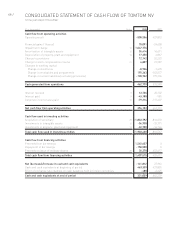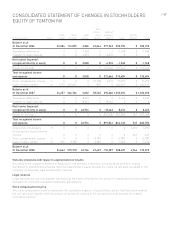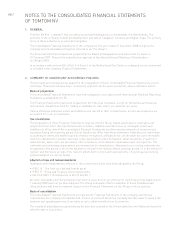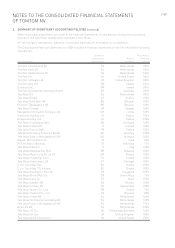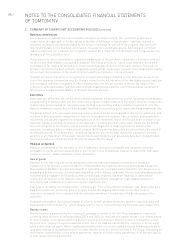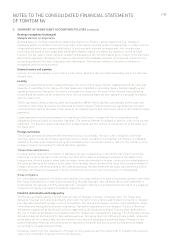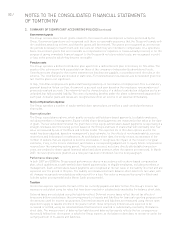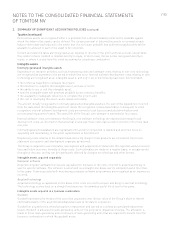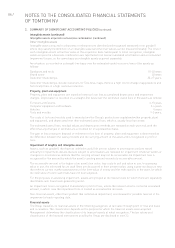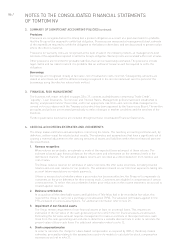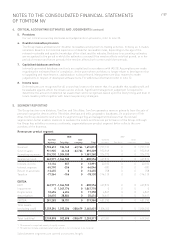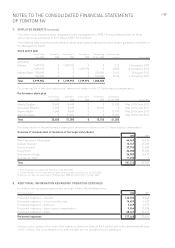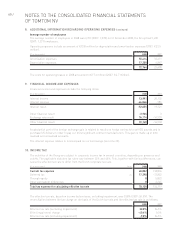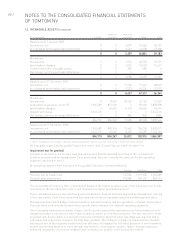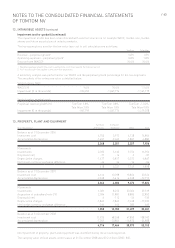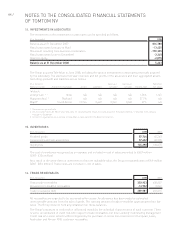TomTom 2008 Annual Report Download - page 58
Download and view the complete annual report
Please find page 58 of the 2008 TomTom annual report below. You can navigate through the pages in the report by either clicking on the pages listed below, or by using the keyword search tool below to find specific information within the annual report.56 / NOTES TO THE CONSOLIDATED FINANCIAL STATEMENTS
OF TOMTOM NV
2. SUMMARY OF SIGNIFICANT ACCOUNTING POLICIES (continued)
Provisions
Provisions are recognised when the Group has a present obligation as a result of a past event and it is probable
that the Group will be required to settle that obligation. Provisions are measured at management’s best estimate
of the expenditure required to settle the obligation at the balance sheet date, and are discounted to present value
where the effect is material.
Provisions for warranty costs are recognised at the date of sale of the relevant products, at management’s best
estimate of the expenditure required to settle the Group’s obligation. Warranty costs are recorded within cost of sales.
Other provisions are recorded for probable liabilities that can be reasonably estimated. The provisions include
legal claims and tax risks for which it is probable that an outflow of resources will be required to settle the
obligation.
Borrowings
Borrowings are recognised initially at fair value, net of transaction costs incurred. Subsequently, amounts are
stated at amortised cost with the difference being recognised in the income statement over the period of the
borrowings using the effective interest rate method.
3. FINANCIAL RISK MANAGEMENT
The business risk report included on pages 38 to 39, contains auditable parts comprising ‘Trade Credit’,
‘Liquidity’, ‘Loan Covenants’, ‘Currencies’ and ‘Interest Rates’. Management policies have been established to
identify, analyse and monitor these risks, and to set appropriate risk limits and controls. Risk management is
carried out in accordance with the Treasury policy which has been approved by the Supervisory Board. The written
principles and policies are reviewed periodically to reflect changes in market conditions and the activities of the
business.
Further quantitative disclosures are included throughout these consolidated Financial Statements.
4. CRITICAL ACCOUNTING ESTIMATES AND JUDGEMENTS
The Group makes estimates and assumptions concerning the future. The resulting accounting estimates will, by
definition, seldom equal the related actual results. The estimates and assumptions that have a significant risk of
causing a material adjustment to the carrying amounts of assets and liabilities within the next financial year are
discussed below.
1. Revenue recognition
When returns are probable, an estimate is made of the expected financial impact of these returns. The
estimate is based upon historical data on the return rates and information on the inventory levels in the
distribution channel. The estimated probable returns are recorded as a direct deduction from revenue and
cost of sales.
The Group reduces revenue for estimates of sales incentives. We offer sales incentives, including channel
rebates and end-user rebates for our products. The estimate is based on our historical experience taking into
account future expectations on rebate payments.
If there is excess stock at retailers when a price reduction becomes effective, the Group will compensate its
customers on the price difference for their existing stock. Customers are eligible for compensation if certain
criteria are met. To reflect the costs related to known price reductions in the income statement, an accrual is
created against revenue.
2. Business combinations
At acquisition all the identifiable assets and liabilities of Tele Atlas had to be recorded at fair value, this
required the Group to carry out a purchase price allocation (PPA). The valuation techniques applied in the
PPA are based on various assumptions. For additional information refer to note 29.
3. Impairment of non-financial assets
The Group reviews impairment of non-financial assets at least on an annual basis. This requires an
estimation of the fair value of the cash-generating units to which the non financial assets are allocated.
Estimating the fair value amount requires management to make an estimate of the expected future cash
flows from the cash-generating unit and also to determine a suitable discount rate in order to calculate the
present value of those cash flows. For additional information refer to note 12.
4. Stock compensation plan
In order to calculate the charge for share-based compensation as required by IFRS 2, the Group makes
estimates, principally relating to the assumptions used in its models to calculate the stock compensation
expenses as set out in note 21.


